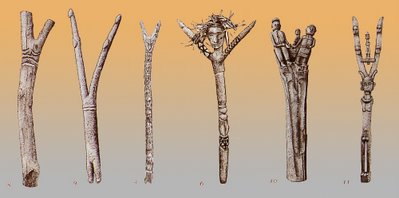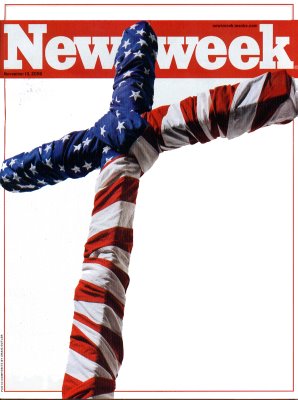
From Carl Schuster, 1996 - left to right: "Y-posts" from Hawaiian Islands; Mangarena; New Guinea; New Hebrides; Borneo; and Sumatra.
My thanks to Ami Ronnberg, Curator of the New York
C.G. Jung Center's Archive for Research in Archetypal Symbolism
(ARAS) who two weeks ago introduced me to Carl Schuster's twelve volume, 3500 page, 7000 illustration,
Social Symbolism in Ancient & Tribal Art produced by Edmund Carpenter and generously "deposited. . .in 600 academic libraries" including the collections at ARAS. Fortunately for poor students, I have been able to find in Denver's Public (read: Plebeian) Library, Carpenter's abbreviated version of Schuster's huge efforts
Patterns That Connect, 1996, Abrams, isbn 0810963264. Though Carl Schuster accepted research grants from Jung's Bollingen Foundation, Schuster's prolific "literary executor" (and defender?), Edmund Carpenter, considers Carl Jung as a lightweight "popularizer" (ibid. pg 8) responsible for "past foolishness" and spouting
"jungian nonsense" (see bio by Carpenter and
bio by Chicago's Field Museum.) But again, thank you, Ami!
While this novice observer sees the "Y-post" (illustration above) as a coital construct with vulvic "V" atop phallic post - the same as our prosaic wine glass - Carl Schuster equates the Y-post as (ibid. pg 14)- "the image of a tree with the branching of the human race. This correspondence between Tree & Genealogy lies beneath a wide range of cultures, in fact, Culture. Ultimately it rests on the analogy of plant propagation and the notion of human birth from budding."
"By its branching, the Tree symbolizes the Tribe, and thereby especially its ancestors to whom sacrifice must be brought. To me, the forked post is the symbolic reduction of the Tree (its use in connection with sacrifice, though important, merely extends its basic meaning as Tree)."
"This association of Tree & Genealogy dates from a least Upper Paleolithic times. What began, I assume, as a 'natural' metaphor, became- quickly, perhaps - an elaborate symbolic system that included limb-sharing ancestors, two-headed, joint-marked figures; and much more. There is nothing 'natural' about these systems: they are inventions, transmitted by word & practice." from Schuster / Carpenter's
Patterns That Connect, 1996, Abrams, isbn 0810963264.
In his defense of Schuster, Carpenter points out that (paraphasing) "nothing about Carl Schuster's work evoked greater skepticism than his approach" which "excluded no relevant category of traditional culture," nor "data from diverse cultures, periods and continents". While their book,
Patterns That Connect, does extend the Y-post motif to patterns on clothing, to "rebirth" gaming boards and ancient labyrinths, nowhere does Schuster's vast collections include obviously related (and I suppose, even less defensible) "everyday" Y-post motifs such as the Maypole, crucifix, wineglass or our cowboy boots atop posts. Perhaps the larger 3500 page version "deposited in academic libraries" includes the populist mundane - we will see on our next visit to academialand.





